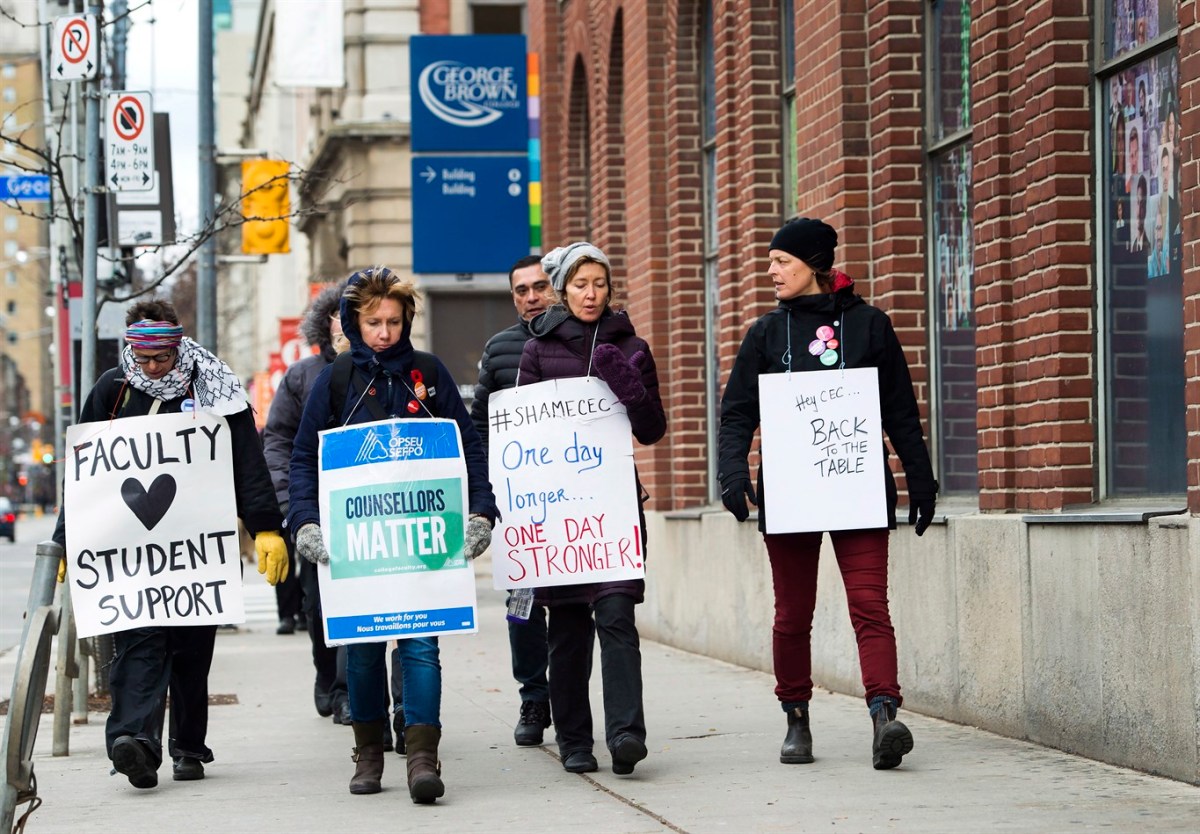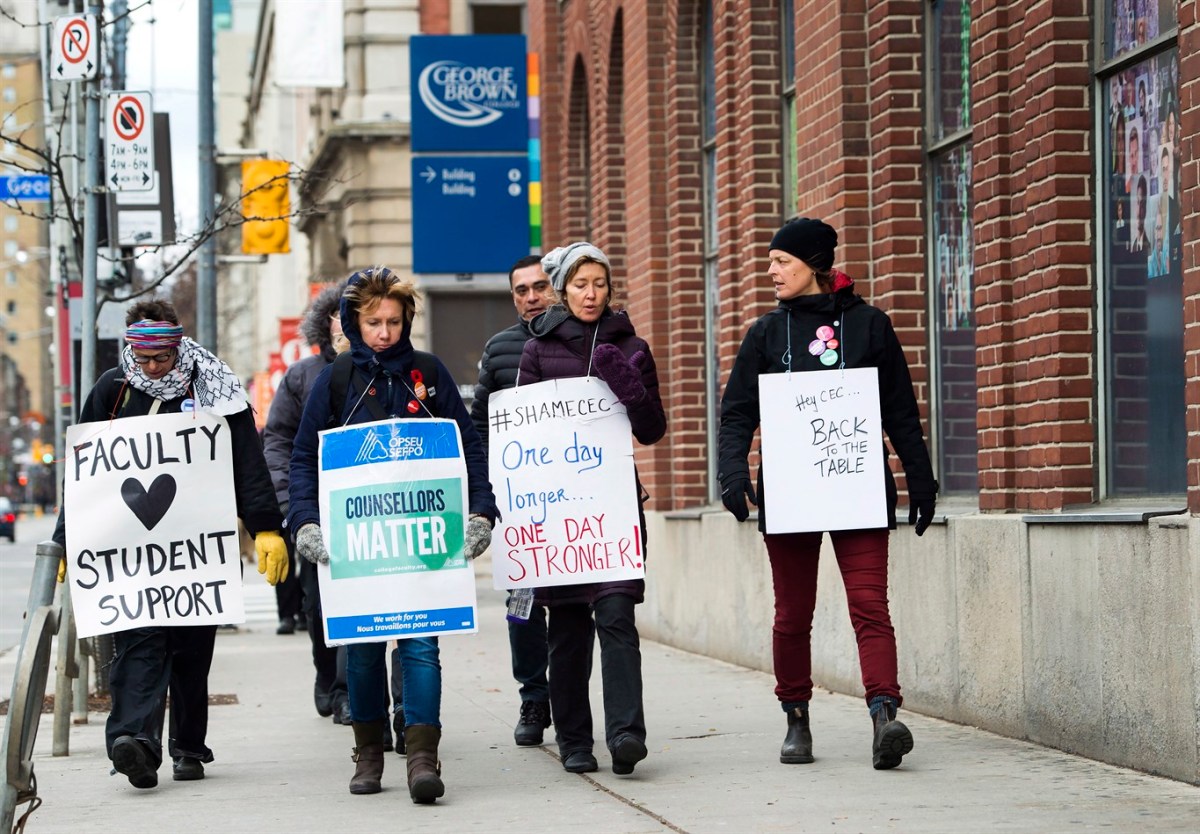Ontario Colleges Faculty Strike: The recent strike by Ontario college faculty sent shockwaves through the education system, impacting thousands of students and raising crucial questions about labor relations, student support, and the future of higher education in the province. This wasn’t just a walkout; it was a clash of perspectives, highlighting the deep-seated issues between faculty demands and college administration’s responses.
We’ll delve into the heart of the matter, exploring the effects on students, the key arguments from both sides, and the broader implications for Ontario’s colleges.
This situation unfolded against a backdrop of previous labor disputes, creating a complex scenario where historical context and current events intertwine. We’ll analyze the economic and social ramifications, examining the ripple effects felt by students, faculty, and the wider community. By exploring public opinion and media coverage, we aim to present a comprehensive picture of this significant event, its impact, and its lasting consequences.
The Ontario colleges faculty strike is seriously impacting students; it’s a real-life drama unfolding. To unwind from the stress, I checked out a completely different kind of drama – check out this game changer movie review for a break. Hopefully, the strike ends soon so students can get back to learning, but until then, finding ways to de-stress is key.
The Impact of the Ontario Colleges Faculty Strike on Students
The Ontario Colleges faculty strike significantly disrupted the academic lives of students, creating immediate and potential long-term consequences. The extent of the impact varied depending on the program, the student’s individual circumstances, and the duration of the strike.
Immediate Effects on Academic Progress, Ontario colleges faculty strike

The most immediate effect was the halt of in-person classes and labs. Students experienced a sudden interruption to their learning, leaving many feeling lost and uncertain about their academic future. Assignments and exams were postponed or cancelled, causing anxiety and frustration. Access to crucial resources like libraries, computer labs, and professors’ office hours was also severely limited.
Long-Term Consequences for Education and Career Prospects
The long-term consequences are harder to predict but could include delays in graduation, impacting career timelines and job opportunities. Some students might experience increased financial strain due to extended study periods. The disruption could also affect students’ overall academic performance and confidence, potentially impacting their future academic and professional success. For students in programs with practicum or internship requirements, the strike could lead to delays in securing those crucial experiences.
Support Services and Their Effectiveness
Colleges offered various support services during the strike, such as online resources, counselling services, and extended deadlines for assignments. However, the effectiveness of these services varied. Many students reported feeling overwhelmed by the lack of in-person support and the uncertainty surrounding their academic progress. Access to technology and reliable internet connectivity also posed challenges for some students, hindering their ability to utilize the online resources effectively.
Comparative Experiences Across Programs
| Program | Immediate Impact | Long-Term Impact | Support Received |
|---|---|---|---|
| Nursing | Loss of clinical placements, delayed exams | Potential delays in licensing, job market competition | Limited online resources, individual counselling |
| Engineering Technology | Interruption of lab work, project delays | Potential delays in graduation, reduced hands-on experience | Access to online simulations, but limited lab access |
| Business Administration | Delayed coursework, lack of interaction with professors | Potential impact on internship opportunities, job applications | Online lectures, extended deadlines, but lack of personalized support |
| Liberal Arts | Disruption of seminar discussions, delayed essays | Potential delays in graduate school applications, job search | Online resources, but less hands-on support than other programs |
Faculty Demands and Negotiating Positions
The Ontario Colleges faculty union’s demands and the college administration’s counter-offers were at the heart of the strike. Understanding these positions is crucial to understanding the conflict’s root causes and potential resolutions.
Summary of Faculty Demands
The faculty union’s key demands typically center around improved wages, better benefits, and increased job security. Concerns about workload, academic freedom, and the increasing use of precarious employment contracts were also significant factors driving the strike action. Specific demands often vary from one bargaining unit to another.
Comparison of Proposals and Counter-Offers

The college administration often countered with proposals that they deemed financially responsible and sustainable. Disagreements typically arose regarding the percentage of salary increases, the specifics of benefits packages, and the implementation of measures to address workload concerns. The administration might highlight budgetary constraints and the need to balance faculty compensation with the overall financial health of the colleges.
Main Points of Contention
Key points of contention usually include salary increases, benefits, workload, and the use of contract faculty. These issues often reflect a broader power dynamic between the faculty union and college administration, with differing perspectives on fair compensation, working conditions, and the role of faculty within the college system.
Legal Implications and Strategies
The legal implications of a strike are significant, involving labor laws and potential legal challenges from either side. Both the faculty union and college administration employ various strategies, including public relations campaigns, legal maneuvering, and negotiations, to strengthen their positions during the dispute. The use of mediators and the potential for government intervention are also common aspects of the legal landscape surrounding such strikes.
Public Opinion and Media Coverage: Ontario Colleges Faculty Strike

Public perception of the strike was heavily influenced by media coverage, with various outlets presenting different perspectives. Social media played a significant role in shaping and amplifying public opinion.
Public Perception and Media’s Role

Public opinion was often divided, with some sympathizing with the faculty’s demands for better working conditions and pay, while others focused on the disruption to students’ education. Media coverage played a significant role in shaping these perceptions, with some outlets emphasizing the students’ plight, while others highlighted the faculty’s grievances.
Examples of Differing Media Perspectives
Some news outlets might focus on the economic impact of the strike on the broader community, highlighting the lost revenue for businesses near the colleges. Others might focus on the emotional toll on students, showcasing interviews with students facing academic setbacks. Still others might provide detailed analyses of the faculty union’s demands and the college administration’s responses, aiming for a more balanced portrayal of the situation.
Impact of Social Media
Social media platforms like Twitter and Facebook became crucial spaces for disseminating information, sharing personal experiences, and mobilizing public support. Both the faculty union and students used social media to share their perspectives and advocate for their interests. The rapid spread of information and opinions through social media could influence public sentiment quickly and dramatically.
Hypothetical Media Campaign for Resolution
A hypothetical media campaign from the faculty’s perspective might emphasize the long-term benefits of investing in faculty, showcasing how improved working conditions lead to better teaching and student outcomes. A campaign from the administration’s perspective might highlight the financial realities of the colleges and the need for responsible budgeting, while emphasizing their commitment to student success and ongoing negotiations.
Economic and Social Consequences of the Strike
The Ontario Colleges faculty strike had far-reaching economic and social consequences, affecting students, faculty, the colleges themselves, and the broader community. Understanding these consequences is essential for developing strategies to mitigate the impact of future labor disputes.
Economic Impact
The strike resulted in lost wages for faculty and potential financial hardship for students facing delayed graduation and career prospects. Businesses near the colleges experienced reduced revenue due to decreased student activity. The colleges themselves faced lost tuition revenue and potential reputational damage. The province as a whole might face indirect economic consequences due to the overall impact on the education sector.
Social Disruption
The strike caused significant social disruption, impacting students’ academic progress and mental well-being. Faculty members experienced stress and uncertainty due to the job action. The broader community also felt the ripple effects, with families and support networks experiencing the consequences of the disrupted education system. The uncertainty and anxiety surrounding the strike could have long-lasting effects on the community.
The Ontario colleges faculty strike is causing major disruptions, impacting students and the educational system. It’s a tough situation, and honestly, it makes you think about how easily things can go wrong; just like that crazy incident where a drone hit a firefighting plane – check out this article about it: drone hits firefighting plane. Hopefully, the college strike will resolve soon so students can get back to learning without further setbacks.
Long-Term Economic Consequences
Long-term economic consequences could include a decrease in the number of qualified graduates entering the workforce, leading to skill shortages in various sectors. The colleges themselves might face decreased enrollment and financial instability in the aftermath of the strike. The province’s overall economic competitiveness could be affected by a less-skilled workforce.
Potential Solutions to Mitigate Negative Consequences
- Improved communication and transparency between faculty, administration, and students during negotiations.
- Investing in alternative dispute resolution mechanisms to avoid strikes.
- Strengthening the legal framework governing labor relations in the college sector.
- Developing contingency plans to minimize the impact of future strikes on students.
- Establishing a more collaborative and proactive approach to collective bargaining.
Historical Context and Future Implications
This strike is part of a longer history of labor disputes in Ontario colleges. Examining past strikes and the changing bargaining landscape provides valuable insights into the potential for future conflicts and their likely impact.
Comparison to Previous Strikes
This strike can be compared to previous faculty strikes in terms of the key issues, the duration, the outcome, and the overall impact on students and the colleges. Analyzing these historical precedents helps to understand the evolving dynamics between faculty unions and college administrations.
The Ontario colleges faculty strike is causing major disruptions to students’ education, adding to the already stressful academic year. It’s a reminder that even seemingly unrelated events, like the recent incident where a drone hits plane , highlight how easily things can go wrong when proper safety and regulations aren’t followed. Hopefully, the college strike will resolve quickly, minimizing the long-term impact on students’ futures.
Changes in the Bargaining Landscape
Significant changes in the bargaining landscape might include shifts in government policy, changes in the composition of the faculty workforce, or evolving economic conditions. These changes can influence the bargaining power of both sides and shape the nature of future negotiations.
Potential for Future Labor Disputes
The potential for future labor disputes remains high, given the ongoing challenges related to compensation, workload, and job security. The outcome of this strike will likely influence the approach taken by both sides in future negotiations, setting a precedent for future labor relations.
Influence on Future Negotiations
The outcome of this strike, whether a negotiated settlement or a imposed solution, will shape the bargaining dynamics in subsequent negotiations. A successful strike might embolden the faculty union in future demands, while a less successful outcome might lead to a more conciliatory approach. The precedent set by this strike will undoubtedly influence future labor relations within the Ontario college system.
Illustrative Examples of Student and Faculty Experiences
To fully grasp the impact of the strike, it’s essential to consider individual accounts from both students and faculty members. These narratives offer a more human perspective on the complexities of the situation.
Student Experience
Consider a student in their final year of a nursing program. The strike disrupted their clinical placements, delaying their graduation and potentially impacting their ability to secure a job in a competitive market. The stress and uncertainty surrounding the strike caused significant anxiety and affected their academic performance. They had to adapt by seeking alternative learning resources, managing their finances carefully, and dealing with the emotional toll of the prolonged uncertainty.
Their future career plans were directly impacted by the timing and duration of the strike.
Faculty Member Experience
A senior faculty member involved in the strike might express concerns about declining working conditions, increasing workloads, and the erosion of academic freedom. They might feel a strong sense of responsibility towards their students and a deep commitment to advocating for fair compensation and improved working conditions to ensure a high-quality learning environment. Their personal experience with the negotiation process and the strike itself could involve feelings of frustration, hope, and determination.
The potential long-term impact on their students weighs heavily on their minds, shaping their commitment to the collective action.
Last Recap
The Ontario Colleges Faculty Strike serves as a stark reminder of the delicate balance between labor rights, educational access, and the overall well-being of students. While the immediate disruption has subsided, the long-term effects on students’ academic journeys and the future of labor negotiations within Ontario’s college system remain to be seen. The lessons learned from this strike, both positive and negative, should inform future strategies for conflict resolution and ensure that similar disruptions are minimized in the years to come.
Understanding the perspectives of both faculty and students is crucial to finding sustainable solutions that prioritize quality education and fair labor practices.
General Inquiries
What were the main reasons for the strike?
Faculty cited concerns over issues like wages, benefits, and workload, arguing for improved working conditions and better support for students.
How long did the strike last?
The duration varied; you’ll need to specify the particular strike being referenced for an accurate answer.
What were the long-term effects on students’ grades?
The impact varied widely depending on the program and individual student. Some students experienced delays in graduation, while others adapted successfully.
Did the strike affect all Ontario colleges equally?
No, the impact varied depending on the college’s individual negotiations and the specific programs offered.
